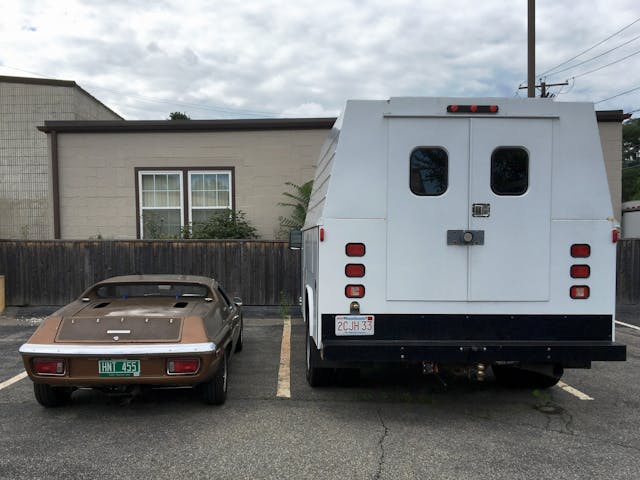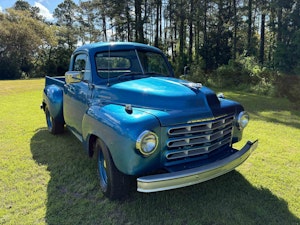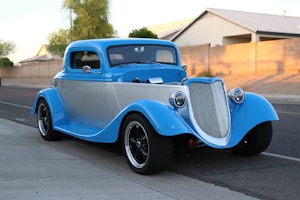Media | Articles
My Cars in Storage Are Revolting (Part II)
Sorry to have separated this from Part I by nearly a month, but two other stories—the Cobra story and being a hostage negotiator for Larry Webster’s Ferrari turn signal assembly—were both too good not to tell . . .
When I was last in the warehouse in Monson, on the Massachusetts/Connecticut border, where I store five cars, they all had difficulties starting, or running, or passing inspection, or all three. “Lolita,” my ’74 Lotus Europa Twin Cam Special was the most troublesome, as it was leaking gas from the 50-year-old rubber O-ring and plastic plug at the bottom of both float bowls. I broke one of the plugs removing it, so I needed to procure the part and go back the following week.

With the leak literally plugged, I got the Lotus inspected. The plan was to then drive it home, but as I described in the first installment, dealing with the vagaries of the other cars made the session in Monson run long, and I didn’t want to drive the tiny Lotus home in rush-hour traffic, so I left the car’s retrieval for another trip.

This created the very happy problem of which car to drive out to the Monson warehouse and leave there when I drove the Lotus back home. Of the “fun cars” at my house, my ’73 BMW 3.0CSi has permanent at-home-pampered-in-garage status. I was planning on taking my 49,000-mile survivor BMW 2002 on its first real road trip, so it needed to stay. Normally, my BMW M Coupe (“the clown shoe”) would be the swapper, but I’d loaned it to a friend for a couple of weeks.
So I did something that you’d think would’ve already happened, but was in fact new to me: I drove “Zelda” the Z3 out to the warehouse. I’ve owned the little ’99 BMW Z3 2.5-liter straight-six roadster for 10 years, interrupted by my selling it to a friend, whose son then drove it over a median strip (no crashed sheet metal, just bent suspension components), and I bought it back so her insurance company wouldn’t total it and part out the car. I’d only sold the car to her in the first place because I’d run out of storage spaces, so when I bought it back, it needed to sit outside, under a cover—something I swore I’d never do to a roadster, but I was out of options, and the car really wasn’t worth anything at that point anyway. It worked out pretty well; I found that as long as it sat covered in the part of the driveway that got sun, both the cover and the car would dry out and stay mildew-free. I haven’t used the Z3 much recently, but whenever I do, I’m instantly reminded how wonderful any drop-top car is in terms of giving you that sense of whole-body relaxation, and a zippy responsive little roadster is just sublime.
Marketplace
Buy and sell classics with confidence

So I did a mini road-trip in Zelda, keeping off the interstate and staying on local roads out to the Monson warehouse as a dry run for doing the same but in reverse in the Lotus. It was heaven, until I heard a scraping sound from the left front wheel during braking. I had this same thing happen with the Lotus when I was sorting it out, and it turned out to be due to pistons on one side of the caliper being seized and thus shoving the rotor into the caliper itself, making it sound like a lathe cutting metal. I drove Zelda gingerly the rest of the way, and made a note to myself to buy a left front caliper and be prepared to replace it in the warehouse when I want to retrieve the car.
So now it wasn’t just the five original cars in the warehouse that were revolting.
Still, if the cars could talk, Zelda would’ve said, “I’m being pampered with indoor storage!” And Lolita would’ve said, “He’s not only spending time with me, he’s bringing me home!”

Little did I know that Lolita was about to throw a total hissy fit.
This was the first lengthy drive I’d had in the Lotus since I put it in the warehouse last September to wait out a registration issue (a story I’ll save for another day). Other than the fact that the lowering springs and adjustable shocks I’d installed cause the car to bottom out on anything other than glass-smooth roads, the drive began well. The Europa is the kind of car that, when you drive 42 mph in a 35 zone, you feel like you should be arrested for the amount of fun you’re having, and, off the interstate, there were many of those roads between the warehouse and home.
Then, on one of these lovely leafy winding New England two-lanes, I got caught behind a lumbering gravel truck. While I was bemoaning the truck’s harshing of my mellow, the Lotus began to behave strangely. At first it stumbled in a way that made me think that the plugs were fouling, but I eventually realized the car was losing power. The narrow windy road didn’t have a great breakdown lane, so I toughed it out as long as I could. Fortunately a church appeared. The car basically died as I rolled into the parking lot.
Then I recalled that, during a drive in the Lotus last year, something similar had happened, and I solved it by reseating the distributor cap. I did the same thing here. It took me a little while—the cap isn’t easy to get to, as the Lotus-Ford Twin Cam engine has a Ford four-cylinder block with the distributor driven by the “jackshaft” (the engine’s original in-block camshaft), so it’s down underneath the intake manifold. The car started, revved, and drove.
And then, about 10 miles later, it happened again. The car began missing, ran worse and worse, lost power, then died where the small road I was on intersected with a local two-lane. And the engine exhaled its last gasp with a backfire so loud that a nearby road worker looked for the source of the gunshot.
Fortunately, there was a wide shoulder and plenty of visibility, and cars had to come to a full stop at the intersection anyway, so I felt safe troubleshooting there. I poked around under the hood (well, under the boot; mid-engine car and all that), and found what was certainly the problem.
Federal-spec Europas like mine have dual Stromberg carbs, which have a warm-up circuit that utilizes cross-pipes from the exhaust manifold to heat up the carbs, as well as a second set of butterflies between the carbs and the intake manifold.

I, like nearly every other Federal-spec Europa owner, had removed the cross-pipes and wired the secondary butterflies open. Only I hadn’t used wire. I’d used zip ties. And I could see that the zip tie on the linkage to the front secondary butterfly had broken, leaving the thing free to just flap around. You don’t have “Eureka!” moments often while troubleshooting, but this fit the symptom perfectly. If the thing flapped shut, with one carb completely starved for air, of course it ran horribly.


I didn’t have any zip ties with me. I almost cut a piece off one of my shoelaces, but then I realized the bag the Lotus’ cover lives in was in the car. I cut the bag’s drawstring, used a piece of it to tie the front secondary butterfly linkage open, patted myself on the back for my diagnostic skills, and set off to what surely would be an uneventful remainder of the trip.

Of course, I was wrong. It died again, this time in the middle of a four-way intersection. In general, Lolita has been remarkably reliable since the excruciating resurrection and sort-out depicted in my book, The Lotus Chronicles, but on this trip, it was completely justifying the old adage that Lotus stands for “Lots Of Trouble, Usually Serious.” I got the car restarted, and with another lunge-and-gunshot-and-die maneuver, got through the intersection and onto a shoulder.
As I sat in the car and thought, I realized that the common thread here was simple: It was time. The car ran fine for a certain amount of time, then ran worse, then died, then revived when I’d waited for a certain amount of more time. What I was doing during that time wasn’t relevant; it was the waiting that was fixing it.
Clogged fuel filter. This is the textbook system of a clogged fuel filter. Contaminants in the gas tank, likely particulate matter like rust or sediment, get carried into the fuel filter. The flow of fuel deposits them against the mesh screen inside the filter. The longer you drive, the more fuel flows, the more blocked the screen gets. When you stop, the contamination doesn’t go away, but enough of it falls off the screen that fuel can flow again. This tends to be worse in fuel-injected cars, where the electric fuel pump delivers 100-psi fuel pressure (typically regulated down to 30 with the surplus sent back to the tank via a return line) that can easily cause contaminants to block either the big visible filter or the tiny mesh screens that are often hidden in vintage fuel-injected cars, but it can also happen in a carbureted car with a mechanical fuel pump delivering 3 or 4 psi of pressure.
The fact that the filter was (apparently) clogged didn’t really surprise me. When I revived the Lotus after its nearly 40-year slumber, I was unable to remove its twin 5-gallon gas tanks to clean them out, so there was no bag of drywall screws dumped in and the tanks thrown into the back of a pickup truck and driven down a bumpy road. There was no taking them to a radiator shop to have them boiled out. There was no rust encapsulation treatment. There was no Red-Kote internal bladder. Instead, I simply took a Scotch-Brite pad and zip-tied it to the end of a rod that I slid around on the bottom of both tanks, then washed them out with gas (hey, you do know what the title of these columns is, right?). Really, the only surprise was that I got five years out of the first filter. But, yeah, I had forgotten about the rusty tanks.
I didn’t feel unsafe where I was, but I was in a highly visible area to be working on a highly visible car. Now that I had the problem nut-shelled—the data showed that I had five to 10 minutes from first-hesitation to dead car—I continued driving to find a better work area. It arrived in the form of the parking lot of a Lowe’s and a BJ’s Wholesale Club. I drove to the edge of the lot, away from prying eyes who might see the amount of gas I was almost certain to dump onto the asphalt.

The fuel filter for the Europa is very difficult to reach. It’s too low and too far forward to easily access from the engine compartment, but the car itself is too low to easily get at it from underneath, unless the car is on a lift. Because the filter is below the tank, I knew that gravity was going to do its thing and cause fuel to go everywhere when I disconnected the lines from the filter. And, of course, because I was lying on the ground and holding the filter in my hand, I also knew that I was going to have the quintessential mechanics’ experience of gas running right into my armpit. As they say in the Army, enjoy the suck.
Fortunately, I had my regular travel tool kit with me (which I throw in the trunk of whatever car I’m running out to Monson), so in addition to grabbing a screwdriver, I readied a pair of quarter-inch ratchet extensions, hoping I could use them to plug the deluge that would certainly flow out of the fuel lines after I pulled them off the filter. I reached up and under, found the filter, found the first clamp, undid it, got the armpit wash, plugged the line with the first extension, then had the repeat experience for the second. Hey, livin’ the dream, right?
With the filter in my hand, I emptied the fuel inside onto a paper towel, expecting to see rust and sediment.
Nothing.
I tapped the filter on the paper towel. Still nothing.
I was stunned. When I’ve had this problem on fuel-injected cars, what’s come out often looks like coffee grounds.
Crap. Had I gotten this wrong?
I wiped off the inlet end of the filter, pursed my lips around it, and blew, like blowing bubbles through a straw.
It wasn’t plugged shut, but I could clearly feel a restriction.
I wiped off the other end and back-blew through it several times. To my delight, I could see a fine gray mist come out. I returned my lips to the inlet side. The restriction appeared to be gone.
Booya!
I re-installed the filter (and re-experienced the armpit enema), verified that the car started, took my bottle of drinking water and rinsed both my actual armpit as well as that of my T-shirt, and drove the remaining 40 miles home, fragrant but satisfied, without incident. Aren’t vintage cars fun?
So, Lolita is home again. I have a lot of work planned for her. I’m going to yank out the suspension, as my attempt to lower the car to Euro specs looks great but produced a car that bottoms out on the smallest of surface imperfections. The plan is to reinstall the springs that were originally on the car, but keep the adjustable shocks.
But not before I replace the fuel filter.

***
Check out the Hagerty Media homepage so you don’t miss a single story, or better yet, bookmark it. To get our best stories delivered right to your inbox, subscribe to our newsletters.






















Yes, we do realize what the title of these columns is, and this story is yet another validation of how apt the name is! But truly, the sequence of diagnosing and treating symptoms until you apparently landed on the correct one was entertaining and educational (in that those things can – in one form or another – fit lots of vehicles other than Europas). Yet another installment of great “Hack Mechanicing”, sir – thanks!
Rob, sometimes we think you should start each article with the statement:
“you can not make this stuff up, honestly.”’
PS: have you ever thought about making a list of the known problems with each car or the know items you have put off for another day and taping it on the steering wheel so when you or your airs go to retrieve the cars they will know not to drive them. Just an idea…
In the past, when I’ve needed to do a road side repair on a car with minimal ground clearance and no floor jack in the trunk, I’ve used parking lot curbing to my advantage. Usually, you can find a place where the curbing ramps down flush with the road, and use that to drive two tires up onto the curb, which gives you anywhere between 4 and 8″ of additional ground clearance to work on one side of the vehicle. Onlookers might wonder what the heck you’re doing, but in my experience nobody really cares.
That’s a very good idea!
Always loved the looks of the Europa, but I dislike finicky machinery. Have you considered ditching all that Federal intake Hokum, and the Strombergs, for a direct connect pair of Webers or DelOrtos? And a remote fuel pump and filter, with proper modern stainless braided lines? And maybe do something about those tanks?😁 Great article, btw. Makes me appreciate my ’66 Cal Look Kafer and ’04 GTO!
I replaced a scrambled CV joint in the rear of a VW 412 wagon lying in the gutter with 2 wheels on the curb in Lusaka Zambia about 51 years ago – when I was much younger, slightly slimmer, and a lot more flexible than I am today!!! (with nothing but a vice grips (actually one of those VERY inferior “MoleGrips” the Britts pass off as “tools”) One of MANY “HackMechanics” episodes I could write about!!!
Yes–Curbs//scrap lumber/tree stumps/ Even spare tire with branches to get it in the air-
This should have a disclaimer please do not do this at home.
I have fabricated and patched cars up on the run if on the road. But never as a primary fix at home before I leave.
It is a braver man than I to continue to take patch worked cars out on the road. I always leave with things repaired as they should be. If not I would never get back home without a flat bed.
I have fabricated carb linkage for a number of carbs 1, 2 and even three and four. I have made the linkage go forward, backward and even 90 degrees. But I never have used Zip ties to make the linkage work on purpose.
You do know what the title of this column is, right? 😁
Why even bother? Just lease a BYD Seagull, trade it in for another when the battery dies.
That might actually work, if there was/ever will be a BYD dealer network in the US to do such a thing.
I’d really like to see one of these cars in person and try to get in. A 42″ roofline just seems crazy. I’ve sat in an MGB one time, with some difficulty getting in and out, and the roof was even down too.
It’s time for Humbert Humbert to abandon his infatuation.
Lolita will never be faithful.
At least you’ll have a very public service record to show a prospective buyer.
audioby… – ” It was love at first sight, at ever and ever sight. And the rest is rust and stardust.”
passed an older alfa romeo 4 door going south from traverse city on US131 sunday with Massachusetts plates. made me think of you. life in the slow lane with the windows down.
It took me a few weeks, not minutes, to figure out that algae had grown in the diesel tank of my diesel Westfalia, and would clog the intake after 10-20 minutes of driving, then allow the van to restart after 10 minutes, etc. I fooled around with the newly rebuilt diesel pump forever before finally figuring it out. Kudos, sir!
A friend owned a new Europa that was a twin of your ‘74…I drove it a few times, it was fun. However, it broke down as often then as your 50 year old does now.
The ones with the Renault Big Valve engine (R16 Gordini ?) were not any more or less reliable – they just had totally different vagaries to uncover
Clare, the S1 and S2 cars had Renault engines. The Twin Cam cars had the Lotus Ford twin-cam engine. The Twin Cam Specials like mine had the so-called “Big Valve” twin-cam engine. The valve size itself isn’t an issue, but the Twin Cam cars have some unique reliability issues due to the fact that the water pump isn’t a bolt-on assembly like any other car, but an integral part of the engine’s front timing cover.
I am part of a Vintage Volkswagen group. Some of us neglect to drive our cars much. This is VERY bad! Because of two vital fluids. NO–NOT engine oil! Brake Fluid and Gasoline! Unerringly, someone will come in his “alternative vehicle” reporting that he is having carburetor problems Hummm–ethanol has worked its magic throughout the fuel system, of course. OR–a person will show at a meeting sans collector car. When quizzed, he reports brake problems. Sigh. Here’s my “equation”. A car not driven will develop a carb problem due to the ethanolized gasoline–somewhere in the fuel system. Now, due to the fuel problem, the car is not driven little or not AT ALL! The next report tells us that the brakes have failed. Or it could be that the brakes have failed first–the car not driven–then the fuel system fails somewhere. The two work together. Never fails with these vintage vehicles. My favorite VW mechanic even rails on me, shouting–“You are ruining your car by not driving it!”. He’s right, you know!
I took my bug out for a spin this week, and when I put my foot on the brake pedal, it went to the floor. Topped off the fluid and pumped the pedal and all was right with the world.
Yeah, I gotta figure out how the fluid escaped, but it was good for five miles.
Cars are like a good woman. They need attention or else pretty soon they’ll leave you by the side of the road.
Dump the secondary intake. Add headers. Tap the jets .025 to.040 down. Pertronix distributor. Upgrade air cleaner. Larger exhaust pipe diameter. I love my 72.
I dunno, is it just me? But how long has this been going on? Rob should by now wake up to the realization that he has always had too many cars. He has skillfully and with a dose of luck, gotten away with this fun problem for a very long time. He has even managed the storage problem many of us face. Now, like many of us, who face the reality of bad backs, energy, finances, and so on, things get real. What Rob continues to do is entertaining, but few of us could keep this up. We wish you all the best Rob. Your explanations of solving problems gives the rest of us hope a when we sit in our garages and wonder why, after all the attention we have given our Webers or SUs or Solex carbs….they still will not idle well!
If he gets rid of these cars, what will he write about? Won’t that put a dent in his income stream?
I think the cars are talking. There seems to be some collusion going on here.